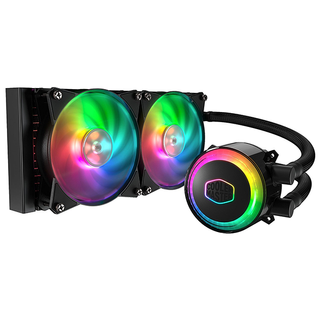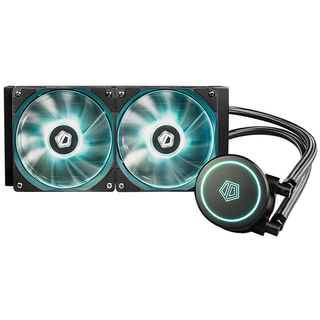Cooler Master MasterLiquid ML240P Mirage Review: See-Through CPU Cooling
Why you can trust Tom's Hardware
Testing Results and Conclusion
Comparison Products
Maintaining data on all coolers we’ve tested allows us to provide analytical data comparison of the Cooler Master MasterLiquid ML240P Mirage amongst peers of the 240mm AIO liquid cooling arena. Our overclocked (4.20 Ghz @ 1.20v) Core i7-5930k provides ample loads to push the thermal load limits of most coolers.
We’ll be comparing the ID Cooling Auraflow X 240, the Cooler Master MasterLiquid ML240R RGB and the Corsair H100i Pro. The latter two of have proven to be some of the best-performing AIOs we’ve evaluated in recent times.
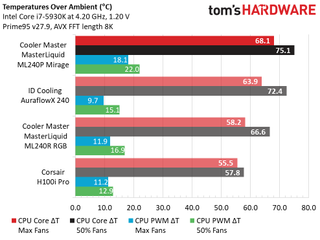
Under load, the Cooler Master MasterLiquid ML240P Mirage is outperformed by its Cooler Master sibling, the ML240R RGB, by nearly 10 degrees C, and even more when compared to the Corsair H100i Pro. Motherboard power delivery also shows the same relative thermal differences across the comparison group.

Radiator fan speed typically offers a bit of insight into how well a liquid cooler performs, since the cooling fans are responsible for exchanging thermal loads from the coolant with the ambient air. Slower fan speeds on both the Cooler Master MasterLiquid ML240P Mirage and the ID Cooling Auraflow X 240 are indicative of the higher thermal load temps seen previously. Likewise, the speedier fans on the Cooler Master MasterLiquid ML240R RGB and the Corsair H100i Pro provide each with quite a performance edge.
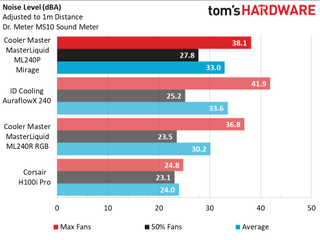
Higher fan speeds often mean higher noise levels, but not always. Lower-speed fans that are not optimal for radiator cooling can result in airflow buffeting back against the fan blades themselves, or imperfectly through the radiator fins.
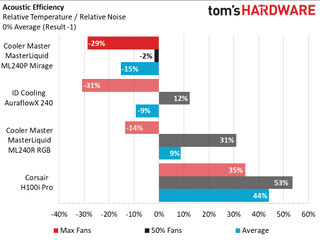
Acoustic efficiency pairs the thermal performance of a cooler against how noisy it operates during the process. Being less-effective and noisy results in a lower score whilst better thermal cooling and lower relative noise provides a more positive result.
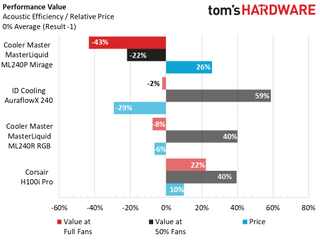
The Cooler Master MasterLiquid ML240P Mirage has an MSRP of $159.99 here on launch day, which makes it the most expensive cooler of the testing quartet by nearly $20 US dollars. Like the acoustic efficiency chart, the performance value takes unit pricing into account but also includes the previous results from the noise level and thermal cooling above.


Imaging from our FLIR ONE Pro thermal camera provides some indication of the heat soak of the ML240P Mirage at 50% fan speed, which is less obvious at 100% fan speeds. We can also see the effectiveness of liquid cooling and the capability of a radiator at dissipating thermal energy from the differences between the coolant tubing lines as well as the middle tubes and the end tanks of the 240mm radiator.
With a price that exceeds that of the better-performing Cooler Master ML240R RGB, it’s hard to find a place where the ML240P Mirage make sense, at least from a value and performance perspective. It also doesn’t come coupled with a dedicated software suite for tuning pump and fan curves, monitoring coolant temperatures and updating firmware. The ML240P Mirage is more visually appealing, but you’re paying extra for looks over performance.
It’s interesting when we see company labels compete against one another more in-house than as a response to market trends. For the release-day price of right at $160, the ML240P Mirage seems to be reaching a bit without the draw of groundbreaking new tech other than a beautiful, clear pump top with addressable RGB lighting cues. If you really like how this cooler looks and / or the price drops, the Mirage is certainly worth considering. But here on launch day, there are better-performing alternatives that cost less.
Image Credits: Tom's Hardware
MORE: Best Motherboards
MORE: How To Choose A Motherboard
MORE: All Motherboard Content
Stay on the Cutting Edge
Join the experts who read Tom's Hardware for the inside track on enthusiast PC tech news — and have for over 25 years. We'll send breaking news and in-depth reviews of CPUs, GPUs, AI, maker hardware and more straight to your inbox.

Garrett Carver is a contributor for Tom’s Hardware, primarily covering thermal compound comparisons and CPU cooling reviews; both air and liquid, including multiple variations of each.
-
spyrosn2006 Guys, sorry, something doesn't click here.Reply
In the Corsair H100i Pro review, the acoustic performance for that AIO cooler is mediocre:
https://www.tomshardware.com/reviews/corsair-h100i-pro-cpu-cooler,5471-2.html
But in this review, we get the following acoustic performance chart for the same AIO:
(Note the H100i Pro at the bottom.)
Could you please point out what the correct value is? 24.8 dBA or 43.7 dBA? It paints the H100i Pro in a completely different color.
